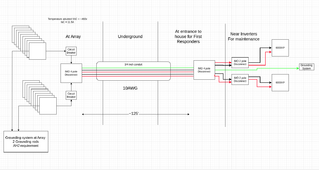I’ve currently implemented a battery backup system using 2 X 6000XP’s and 4 X Ruixu Batteries. See this thread if you’re interested in what I did.
Now it’s time to add my panels. The 6000XP’s have the following specs/limits that I am using in my planning:
I’ve been looking at using the attached BlueSun panels in 2 strings of 8s (one per inverter) or 3 strings of 8s.
Specs for these panels are:
If my calculations are correct. That should give me per string:
If I do 24 panels I was going to just add one more string to one of the 6000XP’s which will give me 12kW.
Does this make sense? Am I missing anything?
Thanx!!!
Thread '6000XP’s/Ruixu Batteries in Production for Home UPS System'
https://diysolarforum.com/threads/6000xp’s-ruixu-batteries-in-production-for-home-ups-system.78032/
Now it’s time to add my panels. The 6000XP’s have the following specs/limits that I am using in my planning:
- Max temperature adjusted VoC of 480 Volts
- Optimal operating voltage of 320 Volts
- Optimal current of 17A with a max of 25A
- Max wattage per MPPT is 4,000 watts
I’ve been looking at using the attached BlueSun panels in 2 strings of 8s (one per inverter) or 3 strings of 8s.
Specs for these panels are:
| Wattage - 460watts |
| VOC - 50.8 volts |
| ISC - 11.5 amps |
| low temp coefficient -0.26% |
| Impp -10.86 amps |
| Vmpp - 42.4 volts |
If my calculations are correct. That should give me per string:
- Temperature adjusted max VoC of ~450V
- Operating voltage of ~340V
- Assuming a nominal bifacial gain of 10% the operating current should be ~12amps
- Optimal wattage of ~ 4080 watts
If I do 24 panels I was going to just add one more string to one of the 6000XP’s which will give me 12kW.
Does this make sense? Am I missing anything?
Thanx!!!




